In interior design, there are basic principles that we must follow to create a more appealing and modern design. Principles like emphasis, proportion, balance, or contrast are the keys to creating an amazing room. The modern design features light and textural spaces that prioritize character and visual comfort by including personal touches, quality materials, cozy and natural textures, and simple silhouettes.
The aim is to create a serene, peaceful, and calming sanctuary while maintaining a luxurious, functional, and clutter-free environment. The modern style features a pared-down neutral color palette of warm whites, beige, cream, pale sand, tan, and light earthy browns. These can be accented with muted colors of camel blush, pink, mocha, olive green, mustard, terracotta, or rust. In this article, we will describe three fundamental modern design principles and how to incorporate them into your space easily using common elements. This is a beginner’s Guide to decorating with modern style.
1. Emphasis
The first trick to making your spaces look professional design and modern is to use the design principle of emphasis. This principle is commonly known as focal points or accent points. If you want to achieve an attractive and effective design, your goal should be to have coexisting dominant and secondary elements, drawing attention to your interior. To pick the element or area to be emphasized, analyze and determine which area or point is more visually striking, then think about highlighting this area or particular element. Let’s look at different and easy ways to use this design principle, as professional designers do.
Ideas to Create a Bold Statement for Modern Design
- Accent Wall
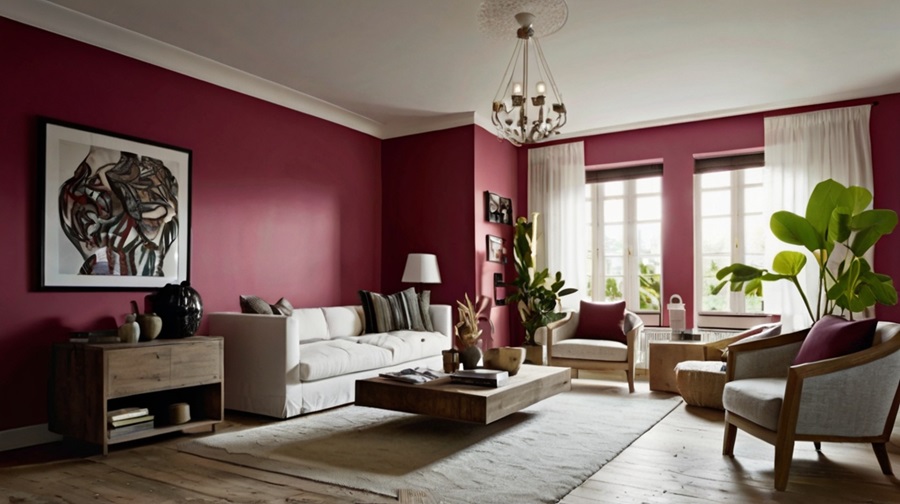
Paint a wall in a contrasting color to instantly modernize your space
Paint a wall in a color that stands out and contrasts with your decoration and furniture. This is a quick and easy way to transform a space into a more minimal and modern space. Just keep in mind your color palette when choosing a paint color that impacts your interior by its contrast or saturation.
- Add a Wallpaper
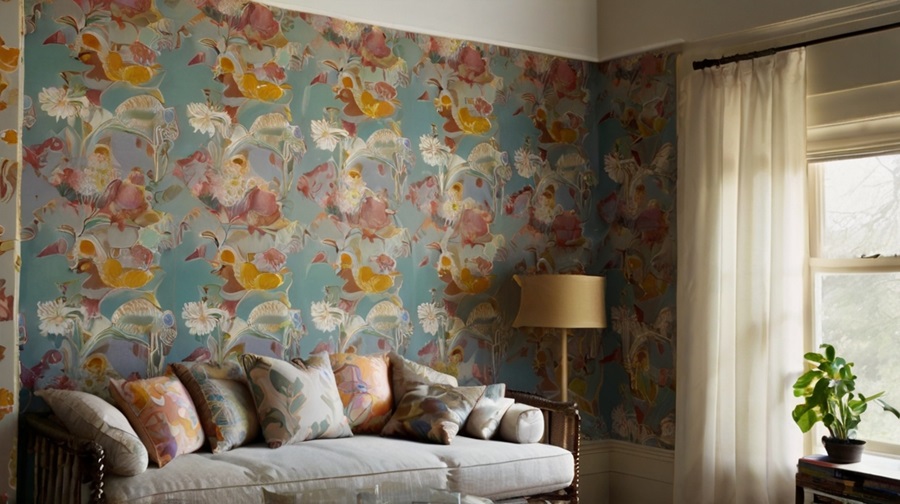
Use wallpaper to add color, texture, and movement
Cover a wall with wallpaper that provides color, texture, and movement.
- Wallart

Select large artwork or mirrors and highlight them with accent lighting to draw attention
Artwork and mirrors are excellent to draw the user’s attention. In this case, you should think about the scale. Make sure you select artwork or a mirror big enough for the wall you hang and the elements surrounding it and highlight your artwork by adding accent light. The accent light will help to emphasize even more your focal point.
- Statement Piece
Another way to create interest in your interior is by adding a statement piece of large furniture or flashy pieces that serve as good focal points. A large sofa in a contrasting and vibrant color will immediately add character to the room. This interesting point will help you draw attention and create flow in your interior. It is one of the best designer secrets for having a more minimal home.
2. color and Proportion
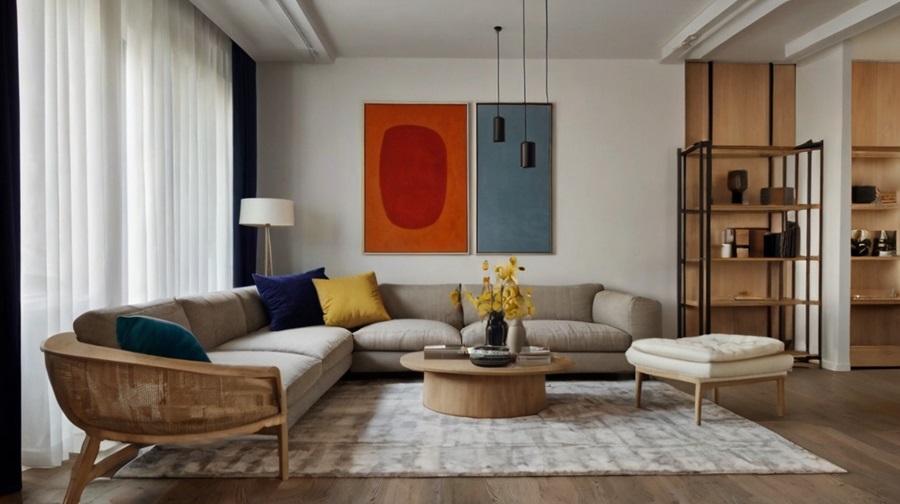
A color palette must have harmony and must be balanced. In most cases, interior designers use neutrals as a backdrop for decoration since neutrals give them versatility and make it easy to use the things they already have at home. Make combinations and change or add something in the future to refresh the space using the accent colors. On the other hand, accent colors add to the pop of the interior. They are necessary to add interest to our focal points to highlight certain characteristics.
To choose a minimal and modern color, designers use a rule to make sure the colors are proportionated to their space and to each other. This rule is called the 63 ten rules. 60% is the overall color of the room. This usually includes the color of your walls, large furniture, rugs, and other big pieces. Ideally, this 60% must be a neutral color that serves as the base and background of your decoration. So first, pick your neutral. The 30% of the room is a secondary color it will support. The dominant color must be different enough to give interest to the space. Usually includes medium pieces such as accent chairs or some walls or rocks.
The other 10% is your accent color. This can be a bold or vibrant color. Its tone will depend on the style and mood you are looking for. But something sure is that color must stand out in this space. In these 10%, you must include your patterns. Incorporate the accent colors, including small pieces such as cushions, artwork, and accessories. This proportion will ensure that the composition is balanced, making it pleasant to your eyes.
Read more: Small Space, Big Impact: Color Palettes for Cozy Homes
3. Textures
The third designer’s secret is to add different textures to the room. Texture is one of the most important elements in interior design because it adds dimension and character to the room, enhancing its appearance and feel. Each object in the space has its own texture. The key is to obtain a perfect blend of textures from all the objects in the space. There are multiple ways to add texture to any room that adds visual interest to your decor.
Read More: living room furniture ideas
Ideas to Add Texture
- Layering fabrics
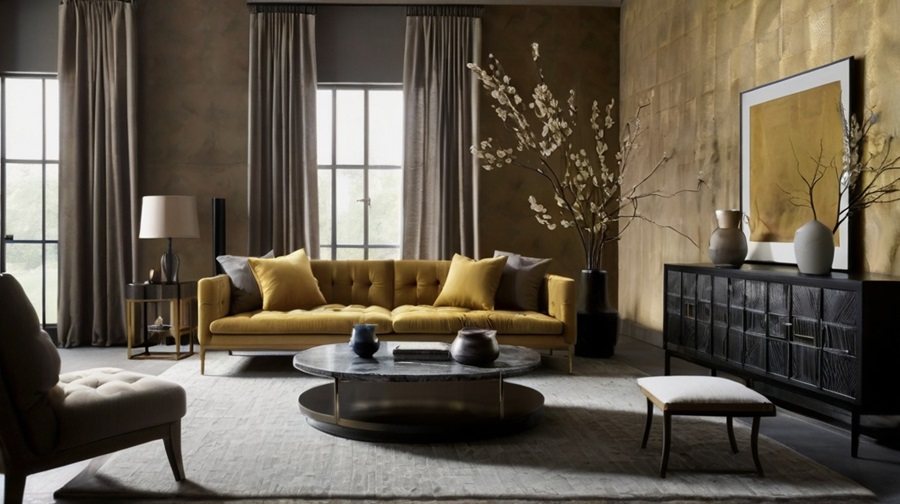
Layer contrasting textures to enhance your modern, minimal design
Layering contrasting textures is key to your modern but minimal design because it balances the composition. If you have a monochromatic scheme, interrupt the consistency by adding fabrics in the room. Some ideas could stabilize your sofa with a throw blanket in different materials of your sofa. Add an armchair in a contrasting texture or pattern. Add texture through the curtains or add a textured rug and cushions. When selecting the texture for each fabric, consider whether it contrasts with the nearby textures. It’s important to look around to pick a contrasting texture with what is existing in your space. For example, if you have a wooden wall covering, don’t add wooden decor elements. Instead, add a candle holder in gold and marble or a matte black base to create minimal and visual interest. Contrasting textures are essential.
- Flowers and Plants
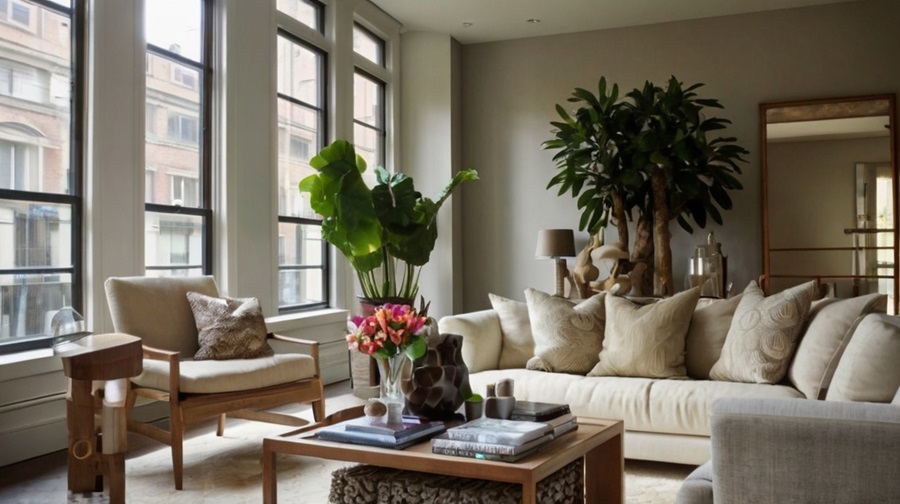
Add flowers and plants to enhance texture in any interior design style
Another great way to add texture to your interior is by adding flowers and plants. The best part of adding plants is that it doesn’t matter what your interior design style is. Plants go well with all interiors and moods. Add a plant to decorate your credenza, a bunch of fresh flowers to add texture to your coffee table, or a tall plant to decorate an empty corner. Design principles are essential to creating amazing spaces, and they are very easy to include in your design.
Bottom-line
When creating a modern and visually appealing space, keep in mind the principles of emphasis, proportion, and balance. To draw attention to focus areas, use bold furnishings, eye-catching artwork, or dramatic color schemes. To design a color scheme that strikes a balance between accent and neutral hues, apply the 60-30-10 guideline. Create a place that is serene, functional, and free of clutter by utilizing a range of textures, fine materials, and distinctive accents.


